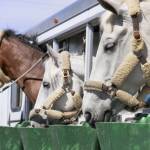Traveling Gear for Transporting Your Horse

The parts of the horse that are most likely to be injured during travel are the legs, tail, and poll, and these can be protected with specially designed accessories.
The legs below the knee, and the coronary band in particular, should be protected. Horses can injure themselves by stepping on their own coronets, pasterns, and heels, or those of the horse in the adjacent stall. Various types of travel boots are available, ranging from those that cover only the cannon bone to those covering from the coronary band up to the horse’s knees. Special knee and hock boots are also available. If the weather is hot, remember that anything on the legs will increase the overall temperature of the horse. Choose strong, sturdy boots. They should be fitted to the legs with the fasteners on the outside of the leg, pointing backwards. Bandages are preferable to cheap, flimsy boots that tend to come off as soon as the horse starts to move around. Bandages should always be used with overreach or bell boots and with boots that do not cover the coronary band. Bandages need to be padded and there is a skill to applying them, so practice before you intend to travel.
When applying or removing boots or bandages, do not kneel on the ground beside the horse because if the horse startles, you will not be able to move away quickly and you may be injured. To apply leg bandages, wrap the padding smoothly around the leg below the knee, with the overlap to the outside of the leg. Start to bandage down the leg, passing the bandage around the leg from one hand to the other. Keep the pressure even (but not tight) as you work down the leg. Go as far down as the coronet and then bandage back up the leg. The bandage should end just below the knee. To remove a bandage, unfasten the ties and quickly undo the bandage without attempting to roll it up as you go. Once the bandage has been removed, you can roll it up, starting with the ties in the middle of the roll.
A tail bandage will prevent the horse damaging its tail by rubbing it on the tailgate. It also prevents damage to the skin under the tail if the horse gets it over the tailgate. It is easier
to bandage a damp tail. Do not wet the bandage, because it will shrink as it dries and may cut off the blood circulation to the tail. Position the bandage underneath the thick end of the dock. Wrap firmly and evenly down toward the end of the dock, and then back up again. Tie the fasteners on the outside of the tail approximately halfway up. Do not tie the bandage or the fasteners tightly. Never leave the bandage on overnight because the blood supply to the tail is easily damaged by pressure. To remove the bandage, undo the fasteners and ease the bandage gently from the top of the dock down the tail and then slide it off without trying to unwrap it. If the horse has a very full tail, this might be difficult and you will then have to unwrap the bandage. Remember to be gentle, both putting the bandage on and pulling it off, because you are working in a very sensitive area of the horse. In some cases a tail bandage may not be sufficient protection because the horse habitually leans on its tail while traveling. The damage to the tail can be extensive. Such horses have often been subjected to poor driving technique, which has caused them to lean back as they try to balance. Make sure that the stall in the trailer is large enough for the horse and if there is room, hang a tire or tire inner tube at the back of the stall for the horse to lean on.
If the horse receives a heavy knock to the poll area (between the ears) by hitting its head on the roof of the vehicle or trailer, serious injury or death may occur. If the horse tends to panic while traveling, you should fit it with a poll guard. If you cannot find one, you can improvise by attaching some foam rubber around the headpiece of the halter.
The number and type of blankets that the horse needs while traveling are determined by the air temperature both inside and outside the trailer. In most cases it is best not to blanket the horse when traveling because the stress of being transported can cause increased heat generation. If there is more than one horse in the trailer, the internal temperature can rise dramatically, depending on the external temperature and the amount of ventilation. Nevertheless, always pack spare blankets, and on long journeys make frequent stops to check the horses. If the horse is blanketed while traveling, check that the chest straps do not stick into the horse as it leans on the breast bar.








